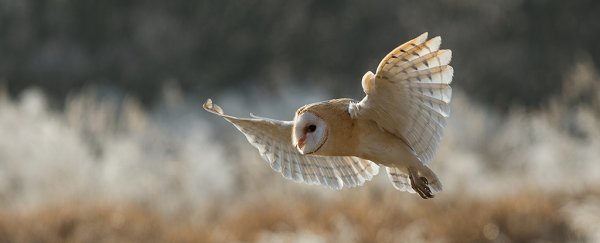Owls have mastered the art of quiet flight in order to glide down on unsuspecting prey, and now scientists think we can follow their lead to quieten down wind turbines and aeroplanes – and it's all to do with the serrated edges on the front of owl wings.
Those serrations could help us keep down the noise of air rushing past metal, and the scientists have got the computer models and wind tunnel experiments to prove it.
The team from Chiba University in Japan found that the serrations on the leading edge of an owl wing controlled the transition between turbulent and streamlined air flows, and that the same principles could be used in our own machines.
"Owls are known for silent flight, owing to their unique wing features, which are normally characterised by leading-edge serrations, trailing-edge fringes and velvet-like surfaces," says lead researcher Hao Liu.
"We wanted to understand how these features affect aerodynamic force production and noise reduction, and whether they could be applied elsewhere."
The researchers put together wing models inspired by owl wings and tested them with and without leading edge serrations. Previous studies had shown up the comb-like serrations on the wings, but we still don't understand much about what effect they have.
These models were then tested in a large eddy simulation, a standard maths model used by scientists to study air flow, and in a low-speed wind tunnel using particle image velocimetry (PIV) and other force measurements.
It turns out the leading-edge serrations can passively control the transition between laminar (steady) air flow and turbulent air flow across the upper surface of a wing, at angles of attack (AoA) – the relationship between the angle of the wing and the direction of the air flow – between zero and 20 degrees.
In other words, those serrations are crucial to managing aerodynamic force and sound production: they break up the swirling, high-frequency eddies of rushing air hitting the wing into smaller, quieter eddies or swirls.
There is a trade-off between force production and noise suppression though, the scientists found. At AoA less than 15 degrees, serrated leading-edges reduce aerodynamic performance compared with clean leading-edges.
Once that angle goes above 15 degrees – as it often does when an owl is in flight – both aerodynamic performance and noise reduction are improved.
We're still a long way from being able to put these findings into action in turbines, aeroplanes, and anything else we make that flies through the air, but there's now a base of research for others to build on.
"These owl-inspired leading edge serrations, if applied to wind turbine blades, aircraft wings or drone rotors, could provide a useful biomimetic design for flow control and noise reduction," says Liu.
"At a time when issues of noise are one of the main barriers to the building of wind turbines, for example, a method for reducing the noise they generate is most welcome."
The research has been published in Bioinspiration & Biomimetics.
